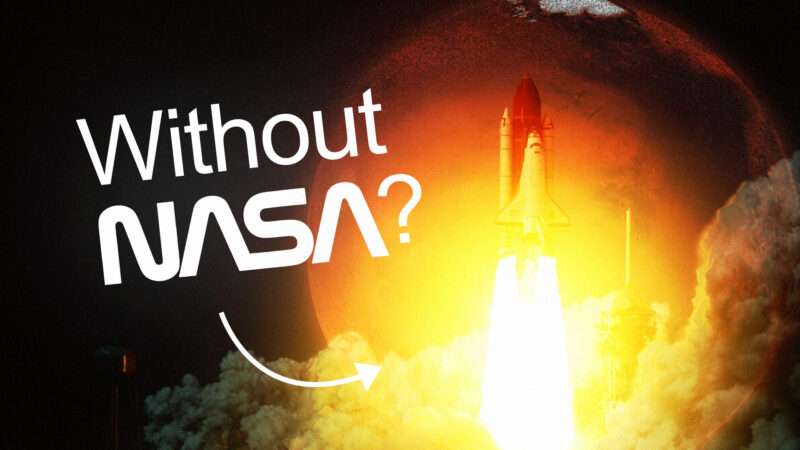
After a few failed launch attempts, Artemis I finally completed its first unmanned journey on December 12, 2022. It's part of NASA's ambitious program to bring American astronauts back to the moon for the first time in half a century. And then on to Mars. That is, assuming NASA can pull it off, which is a big question mark given its record to date. Is the project worth hundreds of billions of government dollars? Is NASA just trying to relive the glory of the Apollo mission?
Could private companies take us back to the moon and Mars faster and cheaper? Most likely, yes.
Artemis is the latest in a long series of setbacks and reversals in America's space program. In 2010, President Barack Obama announced the shelving of the Constellation program, which was NASA's last attempt to bring astronauts back to the moon. The following year, the agency shut down its space shuttle program altogether because of cost and safety concerns. Obama also announced that NASA would begin relying more on private contractors.
Six years later, the Trump administration greenlighted the Artemis program, which was heralded as the beginning of a new space exploration renaissance at NASA.
Artemis I's first three attempts at liftoff were canceled because of leaking issues connected to the rocket's ground system. The fourth attempt, which was successful, brought the price tag to $4.1 billion, and the next three launches are each expected to cost about the same. NASA's auditor estimates that the Artemis program will spend $93 billion by 2025. Because of delays, it's unlikely that a human will make it back to the moon by the end of 2024, as originally planned.
Once upon a time, beating the Soviets to the moon bolstered America's claim to technological and ideological superiority in the 20th century.
"Basically [Artemis] is designed to repeat the Apollo program," says Robert W. Poole, who is the director of transportation policy at Reason Foundation, which publishes Reason and Reason TV. He says that NASA tends to stick to old ways of doing things, isn't particularly interested in cost savings, and its decision making is overly driven by politics.
The hardware that powered Artemis I is known as the SLS—the Space Launch System—and was developed in partnership with Boeing. Critics have another name for it.
"The Senate Launch System, because it was concocted by the Senate as a way to rescue Constellation, give it a new name," says Poole.
NASA would have been better off replacing the costly and dated Space Launch System used in the Artemis program. But it didn't. This probably has a lot to do with the fact that it was largely constructed and engineered in Alabama, the home state of Senate Appropriations Committee Chair Richard Shelby, who has a history of strong-arming NASA to preserve jobs for his constituents.
In 2019, the Senate earmarked $2.58 billion as a starting point to cover the Space Launch System's ballooning price tag. The Senate funding also required NASA to make use of old warehoused materials from Constellation, ostensibly as a cost-saving measure.
"It turns out," says Poole, "it's $600 million just to refurbish the used old tech engines for every single launch."
For four years in a row under two different administrations, NASA got more money from Congress than the president requested.
Ever since Neil Armstrong's one small step, there have been giant leaps in space transportation made in large part by the private sector.
In 2009, the private sector saw one of its biggest champions ascend to become the number two person at NASA. Lori Garver pushed to scrap the Constellation program as a way to entice the private sector to fill in the gaps. She also spearheaded the Commercial Crew Program, which continues to employ commercial contractors to ferry astronauts to the International Space Station. Today, companies like Elon Musk's SpaceX are launching rockets at a faster pace and for a fraction of what NASA spends. In 2022, the company successfully launched 61 rockets, each with a price tag between $100 million and 150 million.
Private companies already design and lease NASA much of its hardware. Poole says there's no reason NASA can't take it a step further and just use the SpaceX starship to cover the entire journey from Earth to the moon and eventually to Mars.
"If the current NASA plan goes ahead to have the SpaceX Starship actually deliver the astronauts from the lunar outpost orbit to the surface of the moon and bring them back, that would be an even more dramatic refutation of the idea that only NASA should be doing space transportation," he says.
Poole says that instead of flying its own missions, NASA should play a more limited and supportive role.
"The future NASA role that makes the most sense is research and development to advance science," he says.
Produced by Natalie Dowzicky and Zach Weissmueller; shot by Issac Reese; edited by Danielle Thompson; additional graphics by Isaac Reese; sound editing by Ian Keyser.
Music Credits: "Main Theme" by Maik Thomas via Artlist; "River Buzz" by Taru via Artlist; "Life" by Angel Salazar via Artlist; "There is a Way" by Alon Peretz via Artlist; "What Do You See" by Sebastian Borromeo via Artlist; "Concrete Walls" by Sebastian Borromeo via Artlist; "Digital Dreams" by Jimmy Svensson via Artlist; "New World" by Angel Salazar via Artlist; "Delivered into Arrival" by Jay Ray via Artlist
Photo Credits: Mediadrumimages/Tiziou News Serv/ZUMA Press/Newscom; (NASA/Bill Ingalls)/Newscom; NASA/Heritage Space/Heritage Images AiWire/Newscom; Ricardo Watson / UPI Photo Service/Newscom; The Print Collector / Heritage Images/Newscom; NASA/Heritage Space/Heritage Images AiWire/Newscom; SIPA USA/NASA/Sipa USA/Newscom; NASA via CNP/Newscom; NASA/UPI/Newscom; Cover Images/ZUMAPRESS/Newscom; Bill Ingram/ZUMAPRESS/Newscom; KEVIN DIETSCH/UPI/Newscom; Aaron Schwartz—CNP / MEGA / Newscom/RSSIL/Newscom; Reginald Mathalone/ZUMAPRESS/Newscom; JP5\ZOB/WENN.com/Newscom; JOE MARINO/UPI/Newscom; Reginald Mathalone/ZUMAPRESS/Newscom; Mediadrumworld.Com/Omaze/Virgin/ZUMAPRESS/Newscom; Blue Origin/ZUMA Press/Newscom; SPACEX/UPI/Newscom; Blue Origin/Mega / Newscom/IBLIM/Newscom; NASA; NASA/ Jim Grossman; NASA/JPL-Caltech/MSSS; NASA/Bill Ingalls; NASA/Kim Shiflett; NASA/Glenn Benson; NASA/Dimitri Gerondidakis; NASA/Jude Guidry; NASA/Heritage Space/Heritage Images AiWire/Newscom
The post We Can Make It To Mars Without NASA appeared first on Reason.com.







